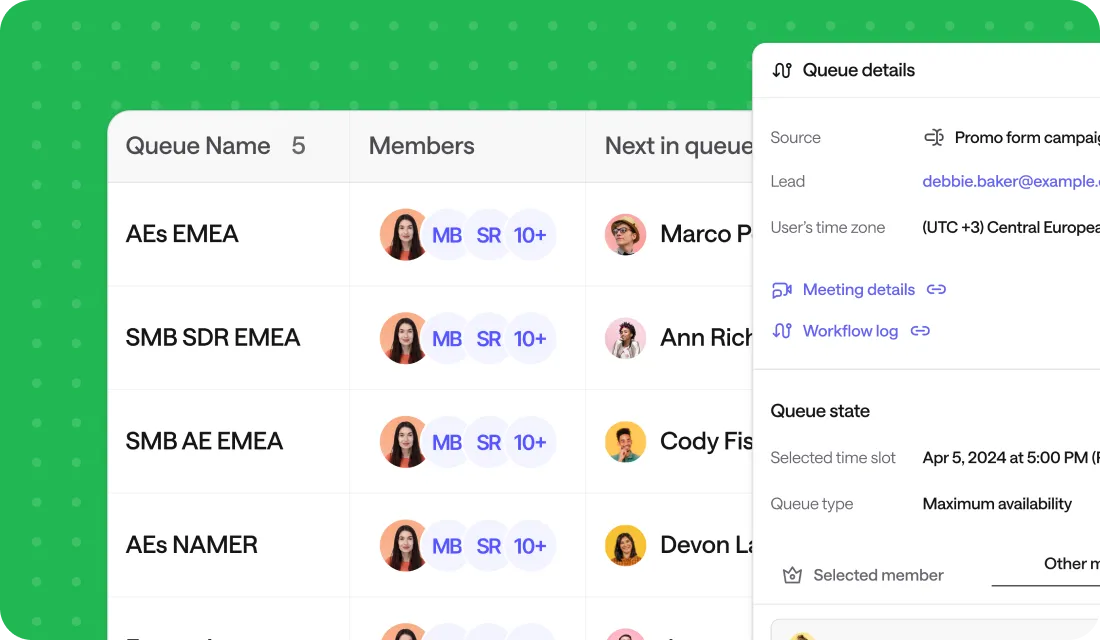Try Default

See how revenue teams automate revenue operations with Default.

Key Takeaways
On the surface level, comparing Chili Piper vs Calendly seems apropos: both are point solutions that handle scheduling and limited lead routing.
But when you dig a little deeper, you’ll find the two platforms have some key differences. Chili Piper is part of the RevOps tech stack, while Calendly is used across the organization. Chili Piper focuses on marketing-sales alignment, Calendly on time management and collaboration.
Despite their differences, however, Chili Piper and Calendly are the same in that they’re excellent at handling isolated use cases. But as holistic solutions to the problems revenue and marketing leaders face, they fall short.
Read on for our comprehensive Chili Piper vs Calendly comparison and the best alternative for modern revenue and sales teams. After reading, you'll be well positioned to make an informed decision for your organization's needs.
Chili Piper overview

Chili Piper’s functionality is fairly limited in scope: capture leads, book meetings, and handoff to sales. And based on user reviews, it seems to handle that functionality pretty well. Add in a straightforward user interface and clever brand identity, and it’s not surprising that they’re well regarded in the market.
Unfortunately, when you zoom out to look at the entire B2B sales cycle Chili Piper’s runs into problems. While you can book meetings with new leads, you can’t build customized forms to capture data. For that, you need an integration. Enrichment is a similar story. And once you “hand off” a lead to sales, Chili Piper doesn’t offer much in the way of follow-up and ongoing engagement.
Because Chili Piper requires an array of integrations to function, you end up trading old bottlenecks in one segment of the customer journey for new bottlenecks in another. It’s not necessarily a net positive.
Read our full Default vs. Chili Piper comparison here to evaluate each scheduling tool.
Calendly overview

In the scheduling software market, Calendly is #1. It’s not even close. And there are a number of reasons why: the platform’s ease of use, its ubiquity across teams and functions, and the fact that Calendly stays in their lane.
While there are many use cases that this solution solves, building scalable, sophisticated tech stacks isn’t one of them. One example is lead routing. While Calendly offers basic round-robin routing functionality, it doesn’t handle dynamic rules-based routing, lead-to-account matching, new contacts within existing accounts, etc.
That’s not a knock on Calendly. It’s just not built for that use case.
As we’ll see in this comparison guide, force-fitting Calendly into the RevOps use case often causes more problems than it solves. If your goal is to create efficiencies and reduce pipeline friction, you’re better off with a platform built for that use case, not a point solution.
Read our Default vs. Calendly comparison to see which scheduling platform comes out on top.
Chili Piper key features
- Automatically book meetings with an easy-to-use, one-click scheduling tool
- Live chat with website visitors to prompt conversion
- Webform concierge with built-in lead qualification software functionality & lead routing to the appropriate sales rep
- Salesforce-centric, trigger-based lead routing
- Automated sales handoff from business development to account managers
- Integrations with dozens of popular marketing and sales tools
Calendly key features
- Customized booking links & web pages personalized for each user and automatically connected with user calendars
- Various meeting configurations—15- vs. 30-minute, one-on-one vs. team, etc.
- Automated team routing feature that limits slotting based on required attendees’ availability while bypassing optional attendees’ conflicts
- Automated reminders and follow-ups for no-shows
- Integrations with dozens of platforms, including your CRM
- Robust, advanced security and back-end admin functionality (enterprise only)
Chili Piper usability
Chili Piper’s ease of use is a constant refrain among user reviews. It takes only a few minutes to schedule your first meeting, and the user interface is intuitive and straightforward. Additionally, the automations seem to run seamlessly in the background, as many users say they’re “not concerned” that meetings are getting booked even while the team is asleep.
The only downside to Chili Piper’s usability is the need for integrations to support core functionality. With no built-in forms, the Form Concierge feature needs third-party configuration to start working. What’s more, lead routing requires a Salesforce account, and despite the CRM’s ubiquity, it’s not the easiest platform to set up and configure.
Chili Piper also struggles with adapting their external-facing assets and capabilities to your brand identity. Some users have complained about requiring developer resources to keep their lead capture and follow-up properties on-brand.
Calendly usability
Likewise, Calendly is built with ease of use in mind. The straightforward user interface enables new users to get started and, like with Chili Piper, start booking meetings within minutes. The only drawback is that some of the customization settings require a bit of hunting to find them.
Calendly has an advantage over Chili Piper in the usability category for two main reasons. First, the platform’s focused functionality helps to avoid feature sprawl. Second, Calendly doesn’t require tangling with third-party integrations to function. Calendly does what it does, and any other capabilities are handled outside the application.
On the downside, Calendly does limit brand customization to those paying for the higher tiers. So if you don’t want that blue logo flashing all over your assets, be prepared to fork out the cash.
Chili Piper integrations
At first glance, Chili Piper’s lengthy list of integrations—including heavy hitters like Salesforce, Drift, Gong, Marketo, Outreach, HubSpot, etc.—seems like it would go in the win column. But given that several of Chili Piper’s core features require integrations to function, that they enable integrations is a less impressive feat.
And yes, these integrations do enable Chili Piper to slot into existing RevOps and GTM tech stacks. But unless they’re used sparingly, stringing together an array of point solutions to build an inbound sales flow can expose your organization to significant risk:
- Prospect and customer dropoff due to bad experience
- Inefficiencies as inbound volume increases and you start scaling your sales funnel—which leads to costly rebuild and redesign
- Lost data as information doesn’t translate from one platform to the other
- Lack of adaptability to changing customer demands and behaviors
- Often requires developer resources to build and maintain these integrations—which quickly becomes costly over time
Of course, it’s possible to overcome these risks while continuing to use Chili Piper. Read to the end to see what that solution entails.
View the full list of Chili Piper integrations here.
Calendly integrations
Not surprisingly, Calendly also has a deep bench of native integrations, namely because their functionality and automations are already so limited. Integration categories include (naturally) calendar apps like Google Calendar, sales & CRM, video conferencing like Zoom and Google Meet, payments, analytics, and more.
Like Chili Piper, Calendly exposes you to risk through extensive use of point solutions. Read on to the end for a tactic that can help mitigate those risks while enabling you to continue using Calendly.
View a complete list of Calendly integrations here.
Chili Piper pricing plans
Perhaps the top reason customers switch from Chili Piper is pricing. So it’s worth it to dive into how Chili Piper pricing works and why it’s so easy for your spend to get out of control.
ChiliCal Free vs. ChiliCal Teams
All Chili Piper users start with their base offering, ChiliCal. ChiliCal Free is pretty bare-bones: you can schedule meetings and auto-detect time zones. ChiliCal Teams starts at $15 per user per month, and adds more features to the list: instant booking (Salesforce required), round-robin routing, scheduling on behalf of other team members, group meetings, branding, Salesforce integrations, and permission control.
Demand Conversion Platform Add-Ons
Once you’ve signed up your team for ChiliCal Teams, you can then start adding one of four additional packages, each of which is priced at $30 per user per month.
- Concierge. Display calendar availability on your website, schedule sales meetings from third-party web forms (including G2), real-time lead qualification, rules-based routing, assignment, and handoff to Salesforce, HubSpot, and more.
- Chat. Leverage live chat to book meetings in a single click, route leads to the appropriate rep, and handoff to your CRM.
- Distro. Automate lead routing based on record creation or updates, qualify in real time, and integrate SLAs, fallback owners, and more.
- Handoff. Route based on CRM data and reference ownership in routing rules.
Depending on how you stack or combine these add-ons, you can save up to $50 per user per month.
Platform Fees
In addition to the per user pricing listed above, each of the Demand Conversion Platform features comes with its own “platform fee” that you’ll find tucked into the fine print (literally, it’s in 6-8pt typeface on their website).
Platform fees vary based on the features you choose:
- Concierge: $150-1,000 per month
- Chat: $1,000 per month
- Distro: $150 per month
- Handoff: $150 per month
Yikes. That’s a pretty hefty increase. So make sure you read everything in your user agreement before signing with Chili Piper.
Calendly pricing plans
Calendly’s pricing is a bit more straightforward than Chili Piper’s and breaks down into four tiers:
- Free. Unlimited 1-to-1 meetings, one event type (e.g. 30-minute vs. 60-minute meeting types), video conferencing integration, and automated reminders.
- Standard ($10/month). Unlimited event types, wide range of calendar integrations, team meetings, handling of scheduling conflicts, and integration with various third-party platforms.
- Team ($16/seat/month). Round-robin meeting routing, automated qualification and prospect routing, and limited Salesforce integrations.
- Enterprise Plan ($15K/year). Advanced features for larger teams, including the ability to enable SSO and SAML, domain control, and full integration with Salesforce and Microsoft Dynamics.
Chili Piper user rating & customer reviews
Chili Piper is a favorite among its user base, gaining an impressive 4.6 out of 5 stars on G2. The biggest pros are its ease of use, scheduling capabilities, and efficiency in booking meetings. The biggest cons are the high price point and difficulty syncing with other applications.
Read Chili Piper’s G2 reviews here.
Calendly user rating & customer reviews
Calendly has slightly higher customer satisfaction than Chili Piper, with 4.7 out of 5 stars on G2. According to user reviews, the platform’s ease of use is the biggest pro. Some occasional bugs, as well as the platform’s limited functionality, are the biggest cons.
Check out Calendly’s G2 reviews here.
Chili Piper overall
Pros
- Ease of use and fast setup—you can start scheduling in minutes
- Handles most B2B use cases well—new users, territories, and complex rules on contact forms
- Scalable pricing and functionality enables you to buy only what you need when you need it
Cons
- Point solution that exposes tech stacks to risk without an underlying orchestration layer
- Requires third-party integrations to function—no built-in webforms
- Lead routing is Salesforce-dependent and doesn’t function natively within the platform
- Difficult to adapt to your brand’s visual identity without additional developer resources
- Complex pricing structure can get out of hand very quickly
Calendly overall
Pros
- Simple, easy-to-use and easy to set up
- Intuitive user experience (UX)
- Limited focus means the core functionality is solid (although users do note the occasional bug or break happens)
- No required integrations for the platform’s core features to work
Cons
- Point solution with limited features beyond their core competencies
- Limited built-in lead distribution—relies primarily on integrations to route leads
- Doesn’t handle recurring bookings very well
- Removing the Calendly branding is only available at the platform’s higher tiers
Calendly vs Chili Piper vs Default

If our assessment of these two scheduling apps seems a bit too critical, we promise we won’t leave you without an alternative. The biggest difference between Calendly & Chili Piper vs. Default is that the latter is the only all-in-one platform for inbound and RevOps management.
Some of the reasons to go with Default include a wider range of features, including:
- Automated, dynamic lead routing based on custom rules and enrichment data that maximizes the chance of success
- Real-time scheduling with out-of-the-box workflow tools to send reminders and follow-ups
- Conversion-optimized forms that integrated directly into your website and increase booking rates
- Third-party integrations and tech stack orchestration to ensure seamless lead flows and reduce dropoff and revenue leakage
What’s more, if you really love working with Chili Piper or Calendly, Default offers a way to keep using those favorite apps while also mitigating those risks. By acting as an orchestration layer for your tech stack, Default can store, maintain, and update your data while ensuring that leads flow seamlessly from one platform to another.
See for yourself why companies are accelerating speed-to-lead by 67% and increasing bookings by 200% by replacing their inbound tech stack. Schedule a demo of Default’s revenue operations software today. with Default today.
Conclusion

Former pro Olympic athlete turned growth marketer. Previously worked at Chili Piper and co-founded my own company before joining Default two years ago.
Accelerate your growth with Default.
Revamp inbound with easier routing, actionable intent, and faster scheduling














.png)























